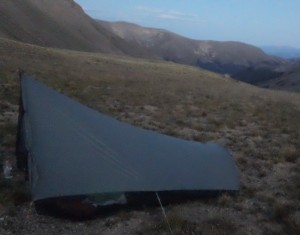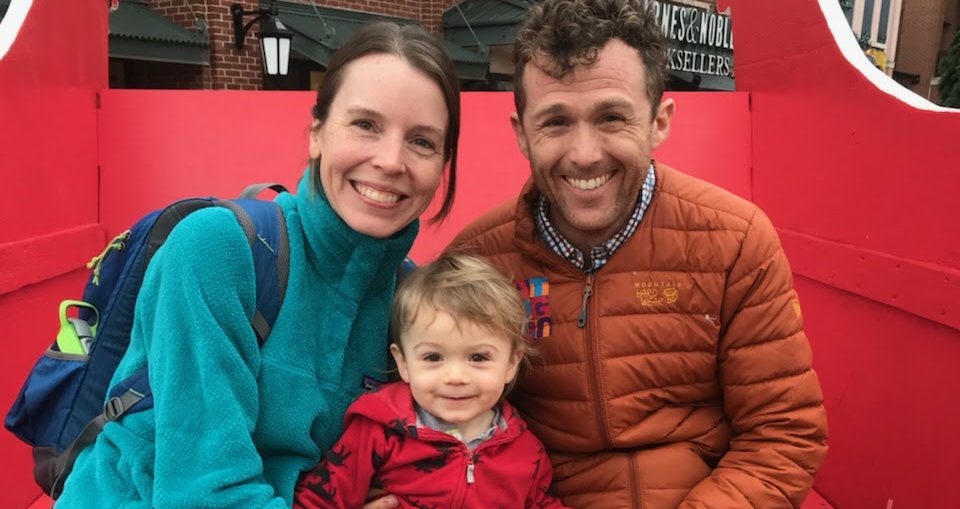
Camping above 12,000 on the Colorado Trail in our Tarp Tent, near the Snow Mesa outside of Creede, CO.
One of the big topics we’re repeatedly asked about regarding our long distance hiking trips has to do with animals, “What did you see?” and “Aren’t you scared of the wildlife out there?” So this article focuses on animals on the trail and how they impact our adventures.
Are we afraid of animals while we’re out there hiking in the wilderness? Sort of…I wouldn’t say we’re overly scared of wildlife on the trail like my mother is of snakes, but we are certainly aware of what is supposedly out there, what their tendencies are, and what we are to do if we have a difficult encounter with an animal. While we have a small sense of the irrational fears on occasion, particularly in the dark, we generally have more of a healthy respect for the animals we’re sharing the trail with and we do our best to avoid conflict with them.
That being said, we definitely had some situations that got the adrenaline rushing while out on the Colorado Trail; there is one night that stands out specifically in my mind. We were nearing the end of the trail and after finishing up a section of the CT where we spent 33 continuous miles above tree line and above 12,000’ elevation, we finally and gladly descended down the Elk Creek Canyon to lower elevations, trees, and water. We found out that while we were excited to be back down with the comforts that come with protection from weather and abundant water, so do the animals.
We found a nice flat spot to camp tucked in between a meadow and a rocky slope on the side of the canyon in a protected patch of trees. The night before we’d had a rocky, windy spot at 12,900 ft so we were ready for flat and quiet in hope of having a good night sleep. We were woken up after a couple hours of sleep to some movement in the rocks behind our tent. My ears perked up, I put my glasses on, and I readied my headlamp in case I had to scope out the scene. Right then the coyotes went nuts! There were seemingly tons of them howling and singing all down the canyon with their yelps echoing off the canyon walls. It was a bright moon that night and while we knew we were witness to a rather unique event and that we should be safe as coyotes aren’t out there hunting humans, it was still chilling and a bit scary laying there on the ground in the middle of the wilderness listening to the coyotes singing in the night.
The coyotes let up after a few minutes and we thought it was time to sleep again. But not long after drifting back to sleep again, I was awoken by the sound of crunching in the night not more than ten or twenty yards from our tent, and it was definitely something big! It was the sound of twigs snapping under the weight of a large animal and it wasn’t the deft, quiet steps of a coyote or a deer. I immediately feared a bear. We generally sleep with our food under our feet in our tent and though we rarely cook where we camp, we put our food in odor-proof sacks, and we keep our food in our packs under our feet, we still are always aware and vigilant regarding the prospect of bears interested in our food. So with Julie and I readied, we both turned on our lights to alert whatever was out there to our presence.
Julie crouched down at the foot of our tent with her light shining out in an effort to see what was out there. Suddenly a large grunt issued forth from the night very close to our tent. Julie instinctually grunted right back at it. It got quiet for a moment and I then decided to get up and out of the tent prepared to hurl rocks at the bear intruder or do whatever else necessary to protect us and our stuff. It was at this point that my light spotted another couple lights not far from our tent. This wasn’t too surprising as we’d seen some other campers not far from our campsite. But after further glance, I realized that what I thought were two headlights were actually two very large eyeballs looking back at me, and they were actually taller than me. My brain did a quick run-through of what those big eyes could possibly be attached to and then it clicked, we had a huge moose standing right outside our tent! We’ve heard they can be aggressive and charge so I calmly and quietly got back into the tent, we turned out our lights, and we listened to two different moose chomping away for twenty minutes outside our tent as we lay there hoping they kept their distance from us and our tent. Thankfully, they eventually moved on and we were able to get some sleep. The next morning, we came across a good-size bull moose in the meadow. The picture below isn’t very good but there wasn’t much between him and us and we weren’t too keen on upsetting him.
Outside of moose and coyotes, the next most hair-raising animals we encountered don’t sound very scary at all: sheep and cows. Cows are actually quite intimidating when walking right up to them, especially when they’re literally right on the trail. Numerous times we found ourselves not only dodging their droppings but trying to calmly speak with them in hopes they didn’t get agitated or nervous by our presence as we walked within feet of them on the trail. They’d typically raise their heads in surprise as we’d near, grass hanging out of their mouths, and after a few moments of looking us over, would normally go back to their feeding. But at times, they’d be noticeably nervous so we’d try and soothe them with calm voices as we slowly made our way through the herd.
Sheep are a totally different story. They noticed us and were very interested in what we were doing there. I don’t think I’d have been as concerned about them had it not been for the guardian sheep dogs that come with them. Our first encounter with a flock happened again in the middle of nowhere, way up in the mountains. We saw the flock from a distance and the trail proceeded to head right for them. As we rounded a bend, we came upon a big shaggy white dog calmly watching us approach. We talked to it and then eventually walked on by. As we got closer to the sheep, with the dog apparently content to sit and watch, Julie suddenly felt a tug on her pack from behind. She looked back to see the sheep dog. It had actually bit her pack and was clearly telling us to keep our distance from his flock. We had no idea what to do. We talked to the dog as if he would tell us what to do and after a few minutes, we were thankful to see the shepherd on a nearby hill yelling at the sheep. Another dog came to round up the sheep and after a few minutes, we were able to pass. Later that day, we came across a sign warning us about sheep dogs and what to do if we encountered them, but that was a little too late for us.
Apart from the scary and the strange, we encountered many other mountain animals. One of our favorites of the high mountains is the pica, a small mouse-like animal that squeaks like a plastic dog toy. They sit on rocks and squeak back and forth to their friends all around the mountain-tops. Along with the squeaks of the picas are the whistles of the marmots, a groundhog-looking creature that lives up in the rocks of the high mountains. They whistle warning others of our presence all along the rocky mountain high trails. We encountered herd of heavy-footed elk as they drank from lakes high up in the mountains and even walked within one hundred yards of a few of them only to feel the earth shake as they stormed off. We also saw what is becoming the standard fare of long distance US trails by spotting one small black bear; it stopped long enough to peer at us for a moment before heading off into the woods. We saw plenty of deer and even some big horn sheep as they posed for the cameras on day one of the hike. Most strangely to us about the animals of the Colorado Trail was the extremely vocal squirrel population. Whether they were grey squirrels or chipmunks, we couldn’t really tell but they would make all kinds of noise regardless of whether we were walking by or if we were sitting down for a snack near their turf. I like to think they were welcoming us to Colorado but realistically think they were a bit bothered by our being on their turf.
In conclusion, I think it safe to say we saw a greater variety of animals on the CT compared to past hikes and with greater frequency. This is speculation as I don’t keep a very close account of everything we see but considering this hike was only 22 days compared to our 100+ day trips on the AT and PCT, it sure seems like we had a lot to share regarding animals. My guess is this has much to do with the remoteness of the Colorado Trail as well as some of the areas we hiked such as the Elk Creek Canyon which is not only a refuge for hikers but also for much of the wildlife of the area. And while we’re not overly scared of the animals of the Colorado Trail, we certainly have a respect and an awareness of them as we share the land with them. However, I don’t think I’ll ever get comfortable with the sound of crunching twigs in the night, be it a bear, moose, deer, or coyote.


